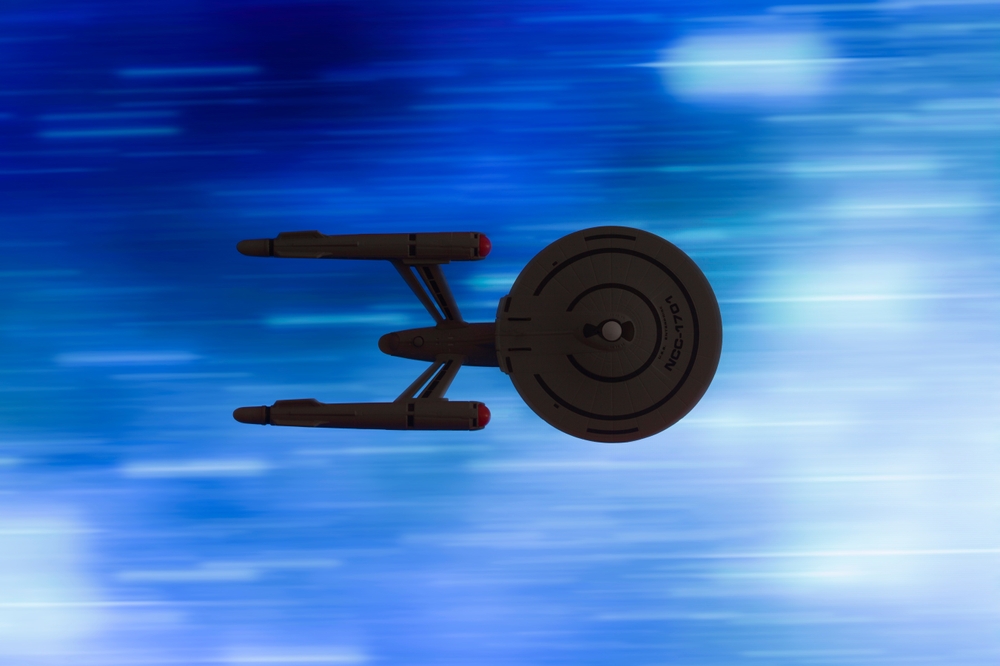Why Warp Drives Are About To Get Better
Posted on Categories Discover Magazine

“Warp speed, Mr. Sulu!” With these words, Captain Kirk of the Starship Enterprise prepared his ship for faster-than-light travel while inspiring a generation of aspiring physicists who watched Star Trek from their sofas.
So it’s no surprise that in 1994, the theoretical physicist, Miguel Alcubierre, worked out how a warp drive might work in the real universe. The key feature of a warp drive is that it can propel a spaceship at superluminal speeds without the occupants experiencing huge acceleration.
Alcubierre’s idea was to create a flat region of spacetime inside a highly distorted bubble of spacetime that moves across the universe. The passengers sit in the flat region where the acceleration is zero, while the bubble as a whole, travels at superluminal speed, or at least exceedingly high velocity.
The big question, of course, was whether the Alcubierre drive was physically possible. The answer turned out to be probably not, because it required negative energy, which is not allowed by our current understanding of physics, and unfeasibly large energy densities.
Bubble Physics
Nevertheless, Alcubierre’s work inspired others to look for alternative warp drives that might be physically possible. In 2021, physicists worked out how to make a warp drive using positive energy, although with unfeasibly high energy density. Indeed, there is a whole class of warp drives.
But evaluating these models is hard because of the fiendishly difficult mathematics behind them. The mathematics involves two stages.
Having come up with a structure for spacetime that might allow warp speed, the first is to solve Einstein’s field equations to determine the flux of energy and momentum. This flux is given by mathematical entities called stress-energy tensors.
Once these have been found, the second stage is to work out whether the stress-energy tensors are physically realistic. In other words, whether they violate the laws of physics or require impractical resources, like infinite energy density.
These calculations are so complex that physicists often revert to simple solutions that make the equations involved more manageable, such as assuming spherical symmetry. However, this inevitably ignores potentially interesting spacetimes with more complex geometries.
Now Christopher Helmerich at the University of Alabama in Huntsville and colleagues have developed a software package called Warp Factory, that takes on the mathematical heavy lifting. “Warp Factory is a specialized toolkit designed for analyzing spacetimes related to warp drives,” say Helmerich and co.
They put it through its paces by characterizing the stress-energy tensors of a range of known warp drive geometries, such as Alcubierre’s, and evaluating their physical plausibility.
None of these models are close to being anything other than mathematical curiosities but the Warp Factory provides new ways to understand them and leads to new insights into their nature. In particular, it allows physicists to study subluminal warp drives in more detail, which may turn out to be the ones of most interest.
“This comprehensive toolkit provides insightful visualizations in both 2D and 3D, offering a deeper understanding of metrics and their corresponding stress-energy tensors,” say Helmerich and co.
Factory Download
The team have made the Warp Factory available for download so anybody can study their design for a revolutionary warp drive. That’s no guarantee that physically plausible warp drives will emerge. But it provides a tool that will surely kickstart research in this area. “We aim to further warp drive research and hopefully bring us closer to realizing physically achievable warp drives,” say the researchers.
So don’t be surprised if more plausible warp drives emerge in the coming weeks and months. Indeed, Helmerich and co hint at as much in their paper. “In a separate paper, currently in preparation, a new constant velocity warp drive solution has been found without energy condition violations,” they say. Just how physically plausible this will be, is not yet clear.
Nevertheless, Mr. Sulu would surely be impressed.
Ref: Analyzing Warp Drive Spacetimes with Warp Factory : arxiv.org/abs/2404.03095